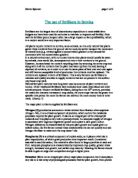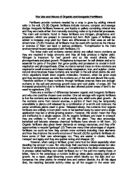The use of fertilisers in farming
The use of fertilisers in farming
Fertilisers are the largest item of discretionary expenditure in most arable farm budgets and have been used for centuries to maintain or improve soil fertility. How well the fertiliser pound is spent often has a large impact on farm profitability, which in a modern world is a very important factor.
All plants require nutrients to survive, as do animals, so it is only natural that plants gather these nutrients from the ground via the roots, by active transport for movement of mineral ions (e.g. nitrate) against a concentration gradient or by osmosis for movement with the concentration gradient.
In a natural environment, with no human intervention plants would usually be eaten by animals, most would die, decompose and return their nutrients to the ground. However, humans break the nutrient recycling chain by removing the entire crop and along with it all the nutrients that the plant had taken up from the soil, leaving it deprived of nutrients, so in order to re-use the same piece of land over and over again and still have an acceptable level of production the nutrients must be replaced. The nutrients are replaced in form of fertilisers. This is why farmers use fertilisers to maintain soil quality and also to supply nutrients that are not present in the soil but may boost crop yield.
Natural farmyard manures have long been used as a source of plant nutrients and humus. Other traditional fertilizers have included bone meal, dried blood and other animal products. Modern artificial fertilisers, dating from the 19th century, provided the means for dramatic increases in crop yields, the more crops that can be grown in a specific time period the more the farmer can sell and the more money there is to be made. (Source 1)
The major plant nutrients supplied by fertilisers are:
Nitrogen (N) provided as ammonium nitrate derived from fixation of atmospheric nitrogen -NH3 it ...
This is a preview of the whole essay
Natural farmyard manures have long been used as a source of plant nutrients and humus. Other traditional fertilizers have included bone meal, dried blood and other animal products. Modern artificial fertilisers, dating from the 19th century, provided the means for dramatic increases in crop yields, the more crops that can be grown in a specific time period the more the farmer can sell and the more money there is to be made. (Source 1)
The major plant nutrients supplied by fertilisers are:
Nitrogen (N) provided as ammonium nitrate derived from fixation of atmospheric nitrogen -NH3 it is a critical component of proteins, which control the metabolic processes required for plant growth. It also is an integral part of the chlorophyll molecule and thus plays a key role in photosynthesis. An adequate supply of nitrogen is associated with vigorous vegetative growth and a plant's dark green colour. Nitrogen deficiency is characterized by reduced plant growth and a pale green or yellow colour. So if a farmer notices these characteristics he can act quickly and add nitrogen fertiliser to make sure the crop doesn't die.
Phosphorus (P) is a critical component of nucleic acids, so it plays a vital role in plant reproduction, of which grain production is an important result. Considered essential to seed formation, this mineral is often found in large quantities in seed and fruit. Adequate phosphorus is characterized by improved crop quality, greater straw strength, increased root growth, and earlier crop maturity. Meaning the farmer should be able to gain an edge over competitors and get a higher price.
Potassium (K) is not an integral part of any major plant component, but it does play a key role in a vast array of physiological processes vital for plant growth, from protein synthesis to maintenance of plant water balance. Reduced plant growth and reduced straw or stalk strength, reduced disease resistance, and reduced winter hardiness of perennial or winter annual crops are indicators of potassium deficiency.
Potentially whole crops could be lost if one or more of the major nutrients are not available for the plant. Resulting in huge losses of money.
Other secondary nutrients supplied by fertilisers to encourage plant growth are Calcium- Ca, Magnesium- Mg (part of chlorophyll) and Sulphur- S, (which improves root growth and seed production)- There are thought to be 16 chemical elements important to a plant's growth and survival. (Source 7 & 8)
These fertilisers are used either individually as "straights" or in combines or "compound" form to provide ratios of plant nutrients matched to crop requirements which is effective for maximising crop yield.
Artificial fertilisers have been of immense benefit in helping to feed a rapidly expanding human population. The view that they are inferior to natural fertilisers is largely unfounded. Plants take in nitrogen ions through their roots whether the source is a sack of fertiliser or farmyard manure. However, excessive application of fertilisers can lead to pollution of streams, rivers and even drinking water. (Extrapolated from source's 1, 4 & 5).
As mentioned above, problems can occur when fertilisers are applied in too a great quantity and the crops cannot take up the fertiliser quick enough. This is a factor that causes run-off of fertiliser containing nitrates, phosphates and ammonia that if washed into lakes or other water bodies can cause eutrophication.
In most freshwater lakes the limiting nutrient is phosphorus, so an input of phosphorus in the form of phosphate ions (PO43-) results in an increase in biological activity- the plants are able to grow and reproduce faster which can cause plant blooms, (e.g. an algae bloom). There are many regulations being introduced that farms are required to follow as an attempt by the environmental agency as to reduce the occurrence of eutrophication. (Source's 2 & 3)
Summery
Although fertilisers can prove an invaluable tool for farmers they can also be a hindrance to the environment and ultimately farmers have to pay the price for clean up operations or fines if they are found to have broken regulations on how much fertiliser they are allowed to put onto their crops. Fertilisers are also very expensive and can also be expensive to spread on the crops, for example the cost of equipment needed may be extremely expensive, especially if an air dropping method is used, as the fertiliser is blown down wind and much falls away from the crops, resulting in wasted fertiliser which means wasted money.
Bibliography
) Webster's family encyclopaedia, Ottenheimer Publishers, book 4 page 926
2) Educational environmental web site ~
http://www.mp-docker.demon.co.uk/environmental_chemistry/topic_4b/
3) Government controlled Environment agency web site ~
http://www.environment-agency.gov.uk//Indicators/Indicator_pages/S4-1.htm
4) Encyclopaedia Britannica CD, 2000 version
5) Hutchinson Dictionary of science, Brockhampton press, pg 123, 1997
6) Marine pollution third edition, R.B Clark, Clarendon Press, 1994 pages 15,17, 134
7) Educational plant nutrient web site ~
http://www.agr.state.nc.us/cyber/kidswrld/plant/nutrient.htm
8) Educational web site ~
http://agguide.agronomy.psu.edu/sect2/sec23a.htm
9)
0)
1)
2)
Steven Spencer page 1 of 2






